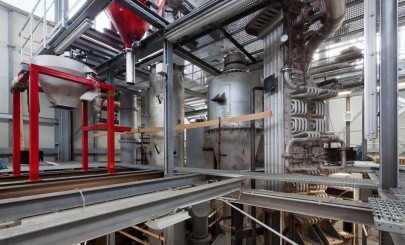On the Way to CO2 Free Power Plants
Innovative methods for capturing CO2 use hardly any energy and add little to operating costs / TU Darmstadt dedicates a pilot plant
The Technische Universität Darmstadt dedicated a pilot plant for capturing carbon dioxide (CO2) contained in flue gases of power plants. Its Institute for Energy Systems and Technology plans to utilize the plant for investigating two innovative methods for CO2 capture that require less energy and lower operating costs than earlier approaches.
Combustion of fossil fuels, such as coal, fuel oil, or natural gas, liberates large quantities of carbon dioxide, a gas that significantly affects global climate. A key technology that would reduce emissions and lead to more environmentally friendly power plants is the capture and storage of carbon dioxide from flue gases of power plants (carbon capture and storage (CCS)). CCS might be able to reduce CO2 emissions resulting from the employment of fossil fuels for power generation and other uses in industry to near zero and thereby contribute to reducing greenhouse-gas emissions. Earlier approaches to CO2 capture require expending significantly more energy and entail greatly increased operating costs, which raises questions regarding their efficiency and acceptance. The TU Darmstadt’s Institute for Energy Systems and Technology’s new pilot plant will be utilized for investigating two new methods for CO2 capture that will allow nearly totally eliminating CO2 emissions and require virtually no additional energy input and entail only slight increases in operating costs.
Over the next two years, the institute’s director, Prof. Dr.-Ing. Bernd Epple, and his 26 coworkers will be investigating the “carbonate looping” and “chemical looping” methods for CO2 capture. Both methods employ natural substances and reduce the energy presently required for CO2 capture by more than half. As Epple put it, “These methods represent milestones on the way to CO2 free power plants. They might allow coal-fired, oil-fired, and natural-gas-fired power plants to reliably and cost-effectively generate power without polluting the environment.”
Technical details
The carbonate looping method involves utilizing naturally occurring limestone to initially bind CO2 from the stream of flue gases transiting power plants’ stacks in a first-stage reactor. The resultant pure CO2 is reliberated in a second reactor and can then be stored. The advantage of the carbonate-looping method is that even existing power plants can be retrofitted with this new method.
On new power plants, the chemical looping method will even allow capturing CO2 with hardly any loss of energy efficiency. Under this method, a dual-stage, flameless, combustion yields a stream of exhaust gases containing only CO2 and water vapor. The CO2 can then be captured and stored.
The investigations of these new methods are being supported with grants totaling seven million Euros from the European Union, the German Federal Ministry for Economic Affairs, and various industrial partners. Due to the pilot plant’s height, the TU Darmstadt has built a new, twenty-meter high experimentation hall on its “Lichtwiese” campus to house it. Construction of the new hall and pilot plant took twenty months. The plant has already demonstrated its ability to bind CO2 in conjunction with initial trial runs.






